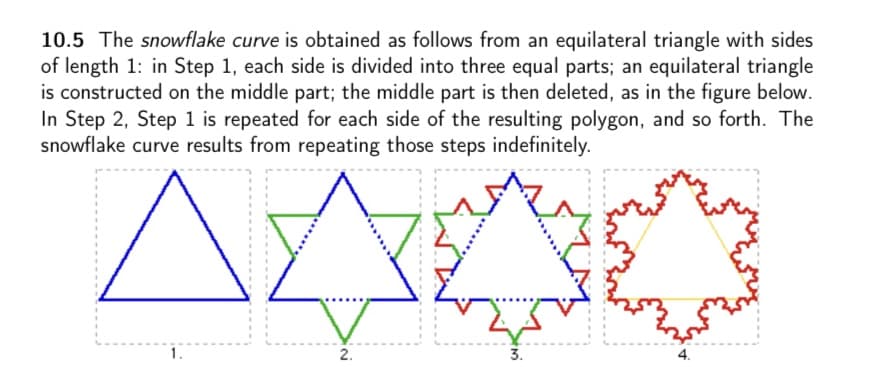10.5 The snowflake curve is obtained as follows from an equilateral triangle with sides of length 1: in Step 1, each side is divided into three equal parts; an equilateral triangle is constructed on the middle part; the middle part is then deleted, as in the figure below. In Step 2, Step 1 is repeated for each side of the resulting polygon, and so forth. The snowflake curve results from repeating those steps indefinitely. 1. 2. 3.
10.5 The snowflake curve is obtained as follows from an equilateral triangle with sides of length 1: in Step 1, each side is divided into three equal parts; an equilateral triangle is constructed on the middle part; the middle part is then deleted, as in the figure below. In Step 2, Step 1 is repeated for each side of the resulting polygon, and so forth. The snowflake curve results from repeating those steps indefinitely. 1. 2. 3.
Linear Algebra: A Modern Introduction
4th Edition
ISBN:9781285463247
Author:David Poole
Publisher:David Poole
Chapter6: Vector Spaces
Section6.2: Linear Independence, Basis, And Dimension
Problem 10AEXP
Related questions
Question

Transcribed Image Text:10.5 The snowflake curve is obtained as follows from an equilateral triangle with sides
of length 1: in Step 1, each side is divided into three equal parts; an equilateral triangle
is constructed on the middle part; the middle part is then deleted, as in the figure below.
In Step 2, Step 1 is repeated for each side of the resulting polygon, and so forth. The
snowflake curve results from repeating those steps indefinitely.
1.
3.
2.

Transcribed Image Text:1. Let sn, In, and p, denote the number of sides, the length of each side, and the
total length of the curve obtained after Step n in the construction, respectively.
Find formulas for sn, In, and hence pn.
2. What is the limit of the length p, of the curve as n → 0?
Expert Solution
This question has been solved!
Explore an expertly crafted, step-by-step solution for a thorough understanding of key concepts.
This is a popular solution!
Trending now
This is a popular solution!
Step by step
Solved in 2 steps with 2 images

Knowledge Booster
Learn more about
Need a deep-dive on the concept behind this application? Look no further. Learn more about this topic, calculus and related others by exploring similar questions and additional content below.Recommended textbooks for you

Linear Algebra: A Modern Introduction
Algebra
ISBN:
9781285463247
Author:
David Poole
Publisher:
Cengage Learning

Algebra & Trigonometry with Analytic Geometry
Algebra
ISBN:
9781133382119
Author:
Swokowski
Publisher:
Cengage

Elementary Geometry For College Students, 7e
Geometry
ISBN:
9781337614085
Author:
Alexander, Daniel C.; Koeberlein, Geralyn M.
Publisher:
Cengage,

Linear Algebra: A Modern Introduction
Algebra
ISBN:
9781285463247
Author:
David Poole
Publisher:
Cengage Learning

Algebra & Trigonometry with Analytic Geometry
Algebra
ISBN:
9781133382119
Author:
Swokowski
Publisher:
Cengage

Elementary Geometry For College Students, 7e
Geometry
ISBN:
9781337614085
Author:
Alexander, Daniel C.; Koeberlein, Geralyn M.
Publisher:
Cengage,

Mathematics For Machine Technology
Advanced Math
ISBN:
9781337798310
Author:
Peterson, John.
Publisher:
Cengage Learning,
